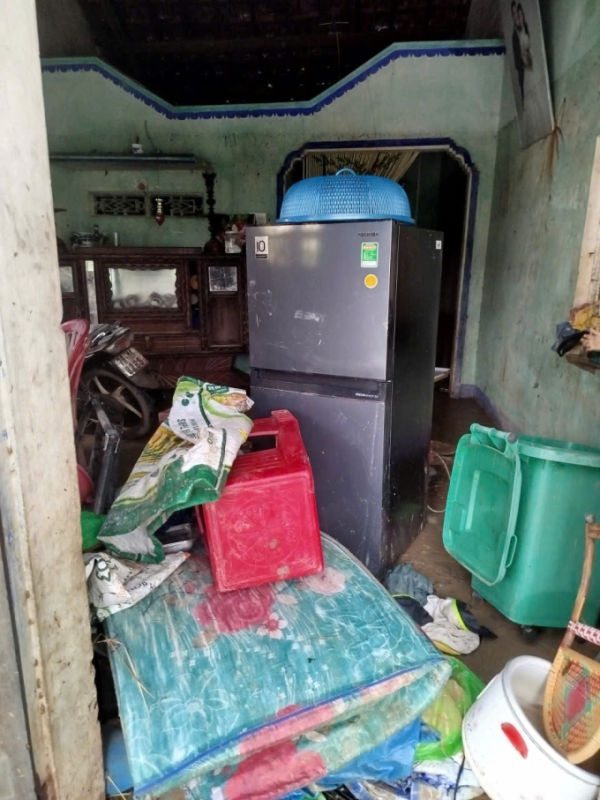
On Nov. 23 the water finally retreated from Thach Tuan hamlet in Hoa Xuan Commune, leaving behind a layer of soft mud several centimeters thick. The 35-year-old Hieu looks around her house and sees just an empty shell since the furniture has been swept away.
Clothes hanging on the line are crusted with mud, pots and pans lie on the floor on the doorway and the air is thick with damp and a sour, fetid smell.
But she says her biggest worry is not how to clean up the wreckage – it is water. “The kids haven’t bathed for days. They itch all over and cry constantly. Their clothes are soaked, and I haven’t been able to wash them. There isn’t a single clean set left.”
|
Relief trucks carrying food, clothing and other necessities drove into flood-hit Hoa Thinh Commune, Dak Lak, on the morning of Nov. 23, 2025. Photo by Dinh Van |
The well in the house did not escape the carnage caused by the flooding, and the water she hauls up from it reeks of mud and decay. “I don’t even dare wash my hands with it,” she says.
She uses rainwater to rinse her children’s hands and feet, but when it comes to cleaning the house, she has no idea where to begin.
For the past four days the only water supply for the five-member family has been a few packs of 450 ml bottled water they bought from a small shop and from relief trucks. Each bottle is opened and shared out carefully, used first for drinking and mixing fever medicine for the children.
Hieu’s family is one of thousands of households in Dak Lak facing a severe shortage of clean water after the historic floods in mid‑November.
In places such as Dong Hoa, Tay Hoa and Hoa Thinh, their main water treatment plant was flooded, damaging pumps and control systems and forcing them to shut down.
More than 38,000 consumers have had tap water supply cut off. Open wells, the main household water source, are either severely contaminated or choked with sediments.
 |
|
Household items lie scattered around My Tien’s residence in Hoa Tan, Dong Hoa Ward, Phu Yen, on Nov. 24, 2025. Photo by My Tien |
Not far from Hieu’s home in Dong Hoa Ward, the family of 25-year-old My Tien is in the same situation. Eight adults and two small children are getting by on donated snacks and instant noodles, and water is a problem.
“The well water is so muddy we can’t cook with it. I use the few bottles of mineral water we have to mix milk for my baby; the adults just skip bathing,” Tien says.
Her mother spends hours wading through mud to clean the house, her arms and legs smeared with dirt, but only dares wipe herself down briefly, accepting long days of itching.
Hong Linh, 35, who leads a volunteer group from Ho Chi Minh City that has been in the flooded areas since the night of November 19, says the lack of clean water is “extremely serious”.
His team took, among other things, some 500 cartons of bottled water in five vehicles to the hardest-hit areas of Hoa Thinh, Dong Hoa and Tay Hoa. According to leaders in Tay Hoa Commune, the shortage of clean water is exponentially increasing the risk of diseases.
Mud, animal carcasses and trash carried by the floodwaters have poured into open wells, making their water unsafe. Local authorities are advising people to disinfect their water with cloramin B before use, but with the wells so muddy and supplyvery limited, this can only be a temporary fix.
The local water supply company is mobilizing workers to repair and replace pumps and clean storage tanks. Water supply is expected to be gradually restored in the coming days. But for people like Hieu and Tien, every hour without clean water feels unending.